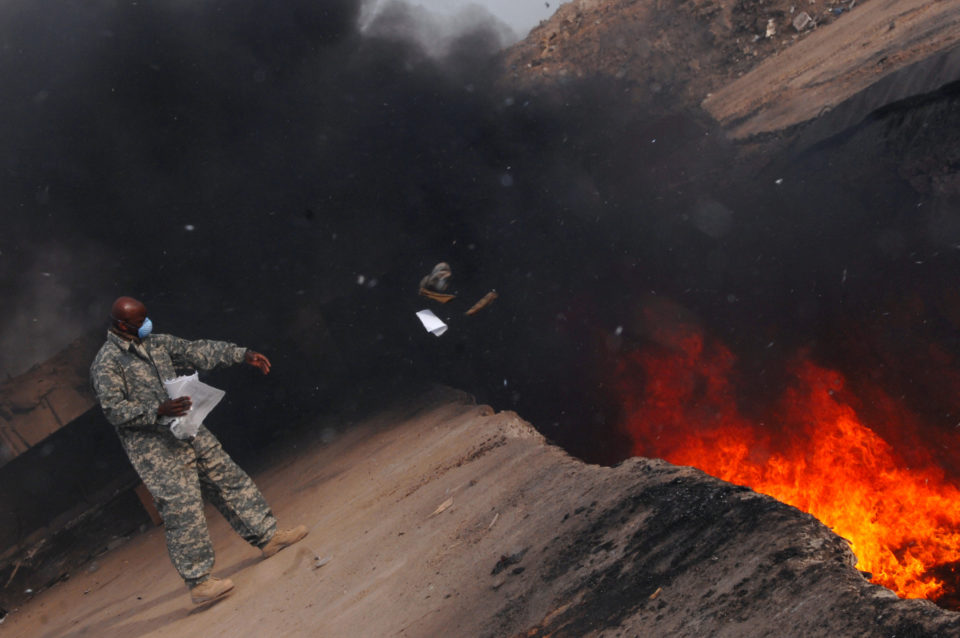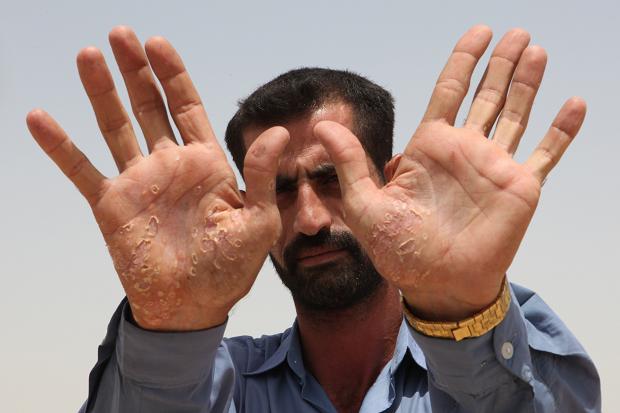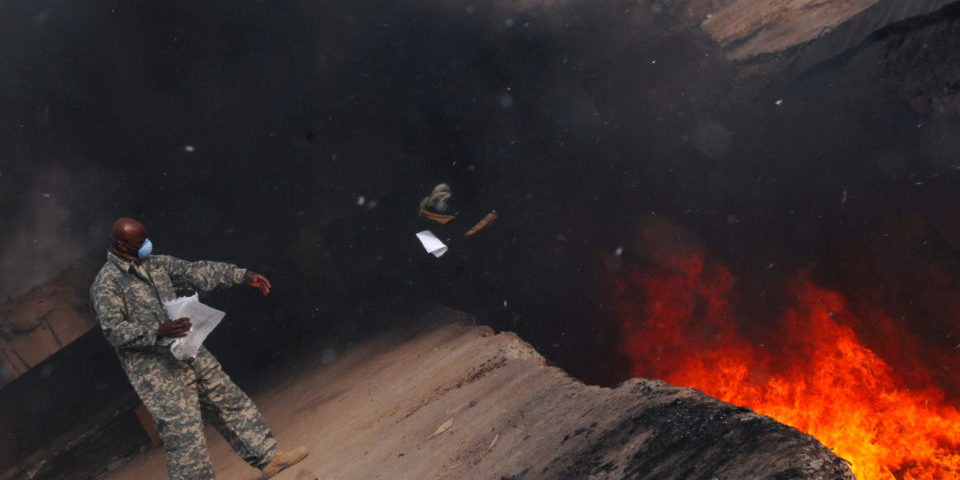Poorly regulated private contractors are playing a growing role in conflicts, what will the consequences be for human health and the environment?

Private military and security contractors have played an increasingly significant role in recent conflicts but a lack of regulation has seen them implicated in examples of serious pollution and with it threats to the health of staff, the military and communities living in proximity to military bases.
Impact of PMSCs on the environment during and after war
While the context of the Iraq and Afghanistan wars differs from much contemporary warfare, the Private Military Security Company (PMSC) industry has grown to such an extent that it would be unwise to ignore its role in future conflicts.
The 2003 Iraq War saw the most significant use of PMSCs to date. While exact figures are difficult to come by, it is said that during the 1991 Gulf War the ratio of troops to contractors was approximately ten to one, in 2007 during the Iraq War, the ratio was roughly one to one.1
Revelations during the Iraq War of PMSC misconduct, such as the 2007 Blackwater shootings, have driven much of the concern over the industry. While this has prompted attempts to develop international policy, such as the Draft of a Possible Convention on Private Military and Security Companies, which was drawn up by a UN working group, references to the environmental and health impact of PMSC activities are limited.
Military operations produce high levels of waste. Military materials and weapons often utilise hazardous substances, such as PCBs, RDX and TNT, which must be disposed of according to hazardous waste disposal procedures. However, ‘everyday’ waste such as plastic packaging and batteries can also cause harm if incorrectly disposed of. Alongside waste produced by military operations, conflict debris including destroyed military equipment, demolition rubble, and old or abandoned weapons can present a significant post-conflict problem. In 2008, it was estimated that 11 million pounds of hazardous waste remained in Iraq;2 its improper disposal could present a major public health and environmental problem.
During the Iraq and Afghanistan wars, the vast majority of military logistical and support services were outsourced to PMSCs, including responsibility for waste disposal. The diligence of PMSC practice can therefore have a significant impact on environmental, civilian and combatant health.3 Worryingly, there have been a number of reports of malpractice.
The most well known have been the misuse of burn pits as a means of waste disposal on US bases in Iraq and Afghanistan. As their name suggests, burn pits are pits in which waste is burned, a practice that can create high levels of air pollution as a result of the incomplete combustion that occurs. Burn pits are meant to only be used during military operations when no other means of waste disposal are possible, they are not recommended as a long-term waste management solution. However, a US Government Accountability Office investigation found that burn pits had instead been used throughout the eight year Iraq conflict because of their ‘expedience’, and prohibited items such as plastic were regularly burnt. Aside from plastics, there have been reports of hazardous waste such as batteries, oil products, medical waste and even human body parts being disposed of in burn pits. Pits were operated in Iraq by Kellogg Brown and Root (KBR), a subsidiary of Halliburton, as a part of KBRs wider role in managing US military bases.
On returning from Iraq, a number of veterans have attributed various chronic illnesses and even death to exposure to burn pits. A group of veterans have taken KBR to court over negligent burn pit management, the case is ongoing. Thus far, little information is available on the impact of burn pits on Iraqi civilians.
US think tank the RAND Corporation reported on a number of cases in which contractors tasked with the disposal of drums of hazardous waste dumped the toxic contents and sold the drums at local markets.4 In another case, contaminated military scrap metal was dumped in an undisclosed location by contractors tasked by the Iraqi Ministry of the Environment to safely dispose of the material.5 The improper disposal of contaminated military scrap metal poses risks as they may contain traces of highly toxic substances such as PCBs, and heavy metals including depleted uranium residues.6

Iraqi worker contracted to dispose of hazardous military waste displays his blistered hands.
PMSCs are also utilised by the oil industry, international agencies and states to conduct demining and munitions disposal work. It is becoming more widely acknowledged that weapons disposal can result in environmental contamination.7 The lack of safe and economical alternatives in Iraq means that munitions are commonly disposed of by controlled explosion or burning, and as noted by the United Nations Environment Programme (UNEP) “[g]iven the scale of the munitions problem in Iraq, large-scale contamination of the disposal sites is considered inevitable.”8
Current regulation of PMSCs
The current regulatory landscape is piecemeal, decentralised and disorganised and varies from state to state. However, in recent years there have been some international efforts to regulate PMSCs, with a convention drafted by a UN working group being the most significant. There have also been soft law instruments developed, such as the Montreux Document and the International Code of Conduct (ICoC). These are essentially best practice guidance on International Humanitarian Law (IHL) and human rights. These instruments are voluntary, non-binding and while like any other issue in International Law, enforcement and implementation is difficult, it is possible to implement these best practice guidelines using contract litigation and corporate liability. A key point however, is that while IHL and human rights obligations are taken account of in these guidelines, environmental obligations are either vague or wholly absent.
What are the implications of this for regulating the environmental impact of the activities of PMSCs in conflict and post-conflict settings? In Iraq, due to the limitations of international and national law, PMSCs contracted by the US government were regulated through contractual agreements9 and SOPs. While these are potentially useful forms of regulation, as accountability can be sought through the US legal system using contract litigation, this is dependent on the diligence with which contracts are written and adhered to, and the social and economic capital of potential litigants.
In the case of burn pits, detailed guidance for their operation was not written into contracts or into military guidance until the issue had become significantly politicised.10 Within demining standards, while environmental guidelines exist, they are non-binding. There is limited information as to whether these guidelines have been integrated into the SOPs of PMSC working in Iraq.
Secondly, the usefulness of contractual agreements depends on the ability of the hiring party to oversee the work of contractors. In Iraq it has been repeatedly found that limited attention was given to contract oversight.11 Importantly, contract oversight officers often lacked expertise in environmental management. Many PMSCs used sub-contractors to undertake work, further complicating oversight and accountability issues. And finally, a key problem in the US use of PMSCs is the dominance in the market of ‘prime contractors’ who are given no bid contracts to undertake military support service.12 The presence of a few very large companies dominating the market has led to a culture of impunity, as is highlighted by the following quote:
“A former KBR logistics contract manager testified before Congress that KBR ‘management would brag that they could get away with doing anything they wanted because the Army could not function without them… KBR figured that even if they did get caught, they had already made more than enough money to pay any fines and still make a profit.”13
While those affected have attempted to seek justice through the US court system, their success has depended to a large extent on their economic, social and political capital. It is hard to imagine how low income Iraqi citizens would be able to access the US courts and take on the highly paid legal teams of the likes of KBR or Halliburton. It could also be asked whether relying solely on contract litigation and corporate liability as a means to hold PMSCs accountable lets the hiring state off the hook.
Implications for efforts to improve the protection of the environment
If, as seems likely, the trend for militaries to outsource support services such as waste management and disposal to PMSCs continues, efforts to strengthen regulation will be needed.
Firstly, steps should be taken to better integrate environmental standards into policy initiatives such as the Draft of a Possible Convention on Private Military and Security Companies, the ICoC and the Montreux Document. These documents make strong references to IHL and human rights obligations however, and as established by the UNHRC’s Independent Expert John H. Knox, “human rights law includes obligations relating to the environment.”14 A strong reference to the environmental human rights obligations of PMSCs and states in policy initiatives, as well as international environmental law, would be a useful start point.
Secondly, those seeking to strengthen the protection of the environment during and after conflict need to be aware of the rise of PMSCs as a key and largely unaccountable actor. Working towards enforcing state responsibility for the actions of PMSCs could potentially be a means of ensuring greater accountability for environmental damage.
Finally, there is a need for hiring states to strengthen contractual obligations for environmental best practice, increase capacity and expertise for environmental oversight, work towards combating the culture of impunity that has developed around PMSCs, and support international efforts to better regulate their activities.
Aneaka Kellay is a researcher with the Toxic Remnants of War Project. With thanks to the contributions of Dr Onita Das, UWE, Bristol.
- D Avant, and R de Nevers, ‘Military Contractors & the American Way of War.’ Daedalus 140.3 (2011) p88-99
- D Botti, ‘The Challange of Making Iraq and Afghanistan Battlefields “Green”‘ Newsweek, 10 March 2008. http://www.newsweek.com/challange-making-iraq-and-afghanistan-battlefields-green-223158.
- As highlighted by UNEP’s Greening the Blue Helmets Report, waste disposal challenges are also faced by UN peacekeeping operations. Sub-contractors are often hired to dispose of waste and capacity limitations are often cited as a barrier to environmentally responsible practices. http://postconflict.unep.ch/publications/UNEP_greening_blue_helmets.pdf p 30
- D Mosher, ‘Green Warriors: Army Environmental Considerations for Contingency Operations from Planning Through Post-conflict’ [prepared for the United States Army] (Vol. 632). (Rand Corporation, 2008)
- IKV Pax Christi (2013) In a State of Uncertainty: Impact and implications of the use of depleted uranium in Iraq
- Toxic Remnants of War Project, ‘Pollution Politics: power, accountability and toxic remnants of war’ (2014)
- [7] F Paktian, Mine Action and the Environment, http://www.jmu.edu/cisr/journal/11.2/feature/paktian/paktian.shtml
- UNEP Assessment of Environmental “Hot Spots” in Iraq, (2005) p50. http://postconflict.unep.ch/publications/Iraq_ESA.pdf
- K Kurera, Military Burn Pits in Iraq and Afghanistan: Considerations and Obstacles for Emerging Litigation.’ Pace Envtl. L. Rev. 28 (2010)
- K Kurera, Military Burn Pits in Iraq and Afghanistan: Considerations and Obstacles for Emerging Litigation.’ Pace Envtl. L. Rev. 28 (2010)
- United States Government Accountability Office, ‘Afghanistan and Iraq, DoD Should Improve Adherence to Its Guidance on Open Pit Burning and Solid Waste Management’ http://www.gao.gov/new.items/d1163.pdf.
- N Tzifakis,’Contracting out to Private Military and Security Companies.’ (2012); S Perlo-Freeman and E Sköns, ‘The private military services industry’ in SIPRI Insights on Peace and Security no. 2008/1
- K Kurera, Military Burn Pits in Iraq and Afghanistan: Considerations and Obstacles for Emerging Litigation.’ Pace Envtl. L. Rev. 28 (2010) p298
- J H Knox, Report of the Independent Expert on the issues of human rights obligations relating to the enjoyment of a safe, clean, healthy and sustainable environment, John H. Knox, Mapping Report. A/HRC/25/53 http://www.ohchr.org/EN/HRBodies/HRC/RegularSessions/Session25/Pages/ListReports.aspx.





